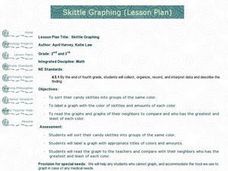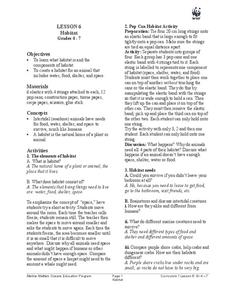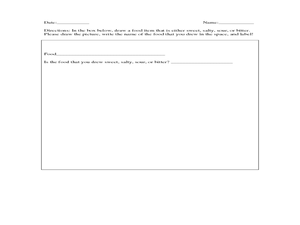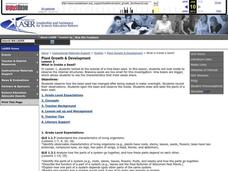Curated OER
Plant Systems
In this plant systems worksheet, students write true or false for the 10 sentences about plant systems. Students then label the parts of the plant.
Curated OER
Skittle Graphing (Lesson Plan)
Students discuss the uses of graphs. They use color candies to count and sort before designing graphs. They label the graph papers with appropriate titles and candy colors. They complete the graph bars, and discuss the results with a...
Curated OER
Thanksgiving Activity: Thanksgiving and Family
Students examine common Thanksgiving foods employing counting, singing, and discussion. Students sing "We Eat Turkey" and discuss what their families eat. Students will then be asked to create and plate of Thanksgiving food and count and...
Curated OER
Calorie Countdown
Students identify the advantages of a healthy diet and exercise plan. In this health lesson plan, students bring in labels of different food products and calculate the amount of calories each serving is. Students keep a food diary to...
Curated OER
Habitat
Students explore the attributes of animal habitats. In this habitat lesson, students examine animal habitats as they conduct a scientific investigation to create an animal habitat that provides food, shelter, and space.
Curated OER
What's the Difference Between Concentration and Solubility?
Students discuss the difference between concentration and solubility as well as examine the difference in a hands-on activity. Using water and table salt, they experiment with solubility. They create different concentrations using water...
Curated OER
Foiling Spoilage
In this agricultural education worksheet, students read 6 descriptions of bacteria that cause food spoilage. Students then read 4 descriptions of preservatives that can be used to prevent spoilage. The worksheet is meant as a...
Curated OER
Terrific Taste Buds
Learners explore descriptive writing by eating food in class. In this descriptive word lesson, students assess different foods in class such as jelly beans and utilize their vocabulary to describe the taste. Learners read the story...
Curated OER
Mixtures are Exciting
Fifth graders collaborate with other classmates to classify and create mixtures made of two or more substances. In this mixture lesson, 5th graders create solid-solid, liquid-solid, and liquid-liquid mixtures. Students discuss with the...
Curated OER
What is Inside a Seed?
Middle schoolers observe how the bean seed has changed after being soaked in water overnight and record their observations. They open the bean and observe the inside. Finally, students draw and label the parts of a bean seed and write...
Curated OER
The Respiratory System
For this respiratory system worksheet, students label the parts of the respiratory system shown in the given diagram. Then they write the name of the structure described on the line. Students also determine the difference between inhale...
Curated OER
Create a Display
Students identify mollusks, create a display, research a particular species, and present their findings to the class. They collect and bring in a shell of choice from their local beach. Then, students label his or her shell with the...
Curated OER
Country Project
Students research any part of the United States that they want to know more about. This may include the culture, food or people. They have to present their information to the class, display a visual aid and write a paper on the...
Curated OER
What Makes up an Ecosystem?
Eighth graders design posters of working ecosystems using pictures from magazines. They label autotrophic, heterotropic, or saprotrophic energy sources, and identify predators and prey.
Curated OER
"The Tiger Who Came to Tea"
Students complete various activities related to the book "The Tiger Who Came to Tea" by Judith Kerr Collins. They participate in a shared reading activity, list the foods from the story, write and read sentences in speech bubbles, and...
Curated OER
All Wrapped Up
Students explore packaging. For this cross-curriculum lesson, students bring in samples of food packaging and identify the packaging as natural or manufactured.
Curated OER
Shells
Sixth graders label diagrams of the 6 different classes of mollusks and explain the meaning of the labeled terms. They identify 8 common New Haven shells. They organize their own shell collection during this series of lessons.
Curated OER
Tooth Structure and Decay
First graders identify the seven parts of a tooth and discuss various foods that can cause tooth decay. They analyze and discuss a poster of the parts of a tooth, discuss what a cavity is, label the parts of a tooth on a worksheet, and...
Curated OER
Make a Birthday Card
Learners use folded paper to design a birthday card to send to a famous person on their birthday paying attention to details such as borders and color. They then draw and label 10 things the person could receive as a birthday present.
Curated OER
The Five Senses
Students use their senses to identify a variety of items in mystery boxes after listening to a read aloud of Aliki's, "My Five Senses." They taste and smell items to identify them before completing a Senses Literature Log. They label the...
Curated OER
Utah History & Geography
Fourth graders calculate and determine the distances between counties in Utah. Using a map of Utah, they determine the distance between three county seats, the total distance round trip, and label a map with the distances.
Curated OER
Animal Adaptations
students in groups to work on bulletin board, making a list of animal adaptations. They write an example of each body covering and find pictures of animals with these coverings. They mount pictures and label the covering. They should be...
Curated OER
Plentiful Plants Book Review
In this literature worksheet, students choose a nonfiction book about plants to read and report about. They note the title, author, illustrator, and publisher. They follow five directions to draw and label plant diagrams, make charts,...
Curated OER
Two Kingdoms of Bacteria
In this bacterial growth worksheet, 9th graders name and describe the three types of bacteria found. Then they label the figure of the bacterium by writing the correct term next to each number. Students also describe the difference...























